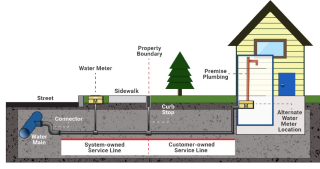Help Us Protect Your Drinking Water

The United States Environmental Protection Agency (EPA) Lead and Copper Rule Revisions (LCRR) require municipalities to inventory water service lines on both the water system side and customer side and to provide a report to the Pennsylvania Department of Environmental Protection (DEP) by October 16, 2024. Therefore, the borough requests your assistance in completing an important survey to document the material of your water service line from the water meter to just outside of your home or business. The inventory will help identify and prioritize the replacement of high-risk materials that could potentially be a source of lead in drinking water. Results of the survey may allow the borough to obtain grant funding to replace water service lines at no cost to you.
Please answer all questions and submit the survey to the borough via mail, email at info@westreadingborough.org, drop box located in the parking lot of Borough Hall, text message to 484-869-5025, or in person at your earliest convenience.
Today, there’s growing awareness that some homes have lead in water pipes, fixtures and plumbing. Lead presents health concerns for people of all ages, particularly pregnant women, infants, and young children. In children, low exposure levels have been linked to learning disabilities, behavioral problems and other issues.
The water leaving the treatment plant and traveling through water mains is almost always free of lead. However, lead is sometimes present in pipes connecting (also known as laterals) older homes to the water system, or in fixtures and home plumbing.
- Have your water tested. You can contact a certified laboratory to have your water tested for lead or purchase an at home water test kit.
- Find out if you have a lead service line. Lead service lines are mostly in homes constructed before the 1950s. You may be able to determine on your own if yours is made of lead. Service lines typically enter the home in the basement or crawl space. If the pipe is lead, it will have a dull finish that shines brightly when scratched with a key or coin. Using a magnet can also help you identify a lead pipe. Even a strong magnet will not cling to lead.
- Have your plumbing inspected. A licensed plumber can inspect both your service line and other materials that come in contact with your drinking water. Lead solders, pipe fittings and brass fixtures can be potential problems.
- Run the Tap Before Use – Lead levels are likely at their highest when water has been sitting in the pipe for several hours. Clear this water from your pipes by running the cold water for several minutes, which allows you to draw fresh water from the water main. You can use this water on house plants or to flush toilets.
- Clean Aerators – Aerators are small attachments at the tips of faucets which regulate the flow of water. They can collect small particles of lead in their screens. It’s a good idea to remove your aerators at least monthly and clean them out.
- Use Cold Water for Drinking and Cooking – Always cook and prepare baby formula with cold water, because hot water dissolves lead more quickly, resulting in higher levels in water.
- Filter the Water – Many home water filters are effective at removing lead. If you purchase a filter, make sure it is certified for lead removal and that you maintain it properly. Find out more on filter certification at www.nsf.org.
The surest way to protect against lead in water is to get the lead out altogether.
- REPLACE LEAD SERVICE LINES
If you have a lead service line, talk to a licensed plumber about getting it replaced. - REPLACE OTHER PLUMBING THAT CONTAINS LEAD
We recommend you use an experienced, certified plumber to look for and replace lead fittings, fixtures or other potential sources of lead.
There are a number of resources available for more information about lead, water filtration systems and other related issues.
CDC – Lead in Drinking Water – The U.S. Centers for Disease Control and Prevention has information on lead’s health effects and tips for protection from water and other common sources of exposure. www.cdc.gov/nceh/lead
Drinktap.org – A public service of the American Water Works Association, drinktap.org was created to provide people information about a variety of water-related issues, from water quality to conservation.
Epa.gov/lead – The federal agency responsible for the safety of America’s drinking water, the U.S. Environmental Protection Agency hosts a comprehensive website that addresses all sources of lead in the home.
Nsf.org – NSF International provides consumer information about water filter capabilities, including claims to reduce lead. The NSF can also be reached at 800-NSF-8010.

